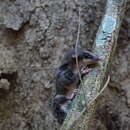en
names in breadcrumbs


Until recently the genus Marmosops was grouped in the genus Marmosa, and the gray slender mouse opossum was known as Marmosa incana. Recents morphometrics and DNA variation analyses showed that M. incanus is sympatric with another slender mouse opossum, M. paulensis (Gardner and Creighton 1989; Mustrangi and Patton 1997).
Perception Channels: tactile ; chemical
---
IUCN Red List of Threatened Species: least concern
The gray slender mouse opossum appears highly insectivorous, feeding mostly on insects belonging to the orders Coleoptera and Orthoptera (de Fonseca and Kierulff, 1989).
Marmosops incanus is widely distributed along the east coast of Brazil, from about 10 to 25 degrees south latitude. (Emmons and Feer (1990); Mustrangi and Patton (1997).
Biogeographic Regions: neotropical (Native )
Marmosops incanus inhabits the humid forest from sea level to 800 m along the coast as well on continental islands. It is also present in the drier, semi-deciduous forest, extending its distribution inland of the coastal mountains onto the Brazilian plateau where it is present at much higher elevations (up to1300 m). Marmosops incanus is also present in gallery forest in the cerrado and caatinga domains adjacent to the Atlantic forest (Mustrangi and Patton 1997).
Terrestrial Biomes: forest ; rainforest ; scrub forest
Marmosops incanus is dark brownish-gray dorsally with craemy-white underparts. The pelage is long (8 - 12 mm along the back) and very soft in young animals. Adults are the same color as young, but have a distinctive, short-haired pelage. These age-related pelage differences were thought to be winter (long pelage) and summer (short pelage) coats. A lateral band of gray-based hairs separates the dorsum from the venter. The eye rings are dark, prominent, and extend onto the snout. The dorsal side of the tail is fuscous, with the last 2 cm or so whitish. Males and females are markedly dimorphic, with males reaching much larger sizes. Adult males range in total body length approximately 270-430 mm and weigh 25-140 g females range in total body length approximately 240-360 mm and weigh 20-70 g. The tail is long, approximately 1.5 times the combined head and body length. The ears are large, averaging more than 25 mm in both sexes. The distinctive adult pelage is also dimorphic. In adult males the hairs of the throat and shoulder regions are replaced by short hairs (5 mm), much stiffer and coarser than in young animals. In females the entire dorsal pelage is replaced by short hairs, but these are soft as in the juveniles.
The dorsal pelage color varies geographically. Individuals from the semi-decidous and gallery forest in cerrado and caatinga habitats are markedly paler gray than those from the wet coastal habitats. Oliveira et al. (1992); Mustrangi and Patton (1997).
Other Physical Features: endothermic ; bilateral symmetry
This species has an interesting life cycle. Breeding occurs during three months (Sept.-Dec.), following which all adult males evidently die, so that none exists in the following seven months (Feb.-Aug.). Adult females survive through May, and then die, so that none are present from June to August when the population includes only young of the year. Males thus have a lifespan of about a year, and females of a year and a half. At birth, the young are exceptionally altricial. There may be geographic variation in the months when breeding occurs, usually during the rainy season. The limited breeding season shown by M. incanus indicates that the female are monoestric and that the estrous cycle is short. Each individual participates in only one reproductive season during its lifetime. However, at least two reproductive periods in the year are found in one population, a major one from Oct. to Dec. and a second, in which fewer animals participate, ocurring from March to May. Tribe (1990); Emmons and Feer (1990); Lorini et al. (1994).
Key Reproductive Features: gonochoric/gonochoristic/dioecious (sexes separate); sexual
The gray slender opossum (Marmosops incanus), is an opossum species from Brazil.
This species is a semi-arboreal marsupial, moving on average 67.38% on the ground.[3] They are solitary, nocturnal, and scansorial (tree climbers).[4] Their diet consists mainly of insects.[5]
The gray slender opossum (Marmosops incanus), is an opossum species from Brazil.
This species is a semi-arboreal marsupial, moving on average 67.38% on the ground. They are solitary, nocturnal, and scansorial (tree climbers). Their diet consists mainly of insects.